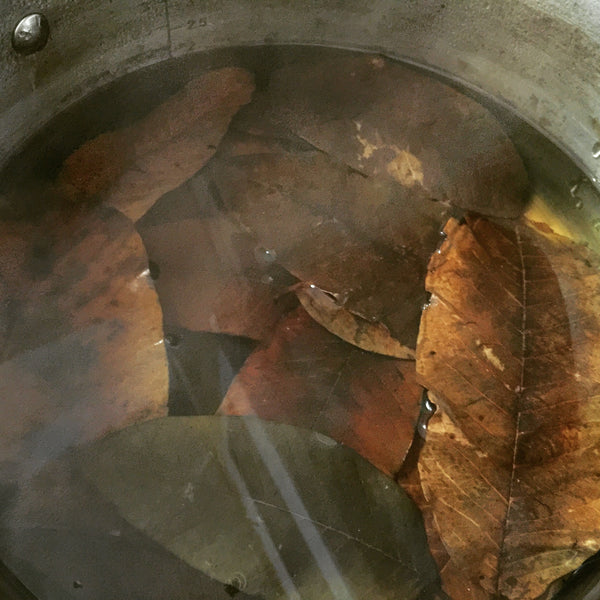- Continue Shopping
- Your Cart is Empty
Yeah, you can collect those leaves....
You know...
You can use leaves and botanicals which you can collect yourself.
We have a lot of people ask us if they can use "such and such" a leaf or seed pod, or whatever they collected nearby -in their aquarium. And quite frankly, for many items, my thinking is that you should give them a try...conditionally.
(Woah, he's advocating collecting your own stuff? Doesn't he have a business? What? Why would he do that? ) Well, yeah, I DO have a business...but why not collect some stuff if you can, right? Sure, when you get stuff from me, you don't have to go tracking through the woods or get wet and dirty, but hey- that's fun for a lot of people! And this is nothing new...people have been collecting various leaves and other botanicals for years. It's kind of fun if you have access to it, and the time and inclination to collect.
Now, first off, you should get an identification about the item(s) you're collecting. You can either look 'em up online ("Did you know that there's now this incredible web page on the 'information superhighway' called Google! It can get you answers for lots of stuff quickly! Try it next time you're on the world wide web!") or purchase a nice field guide to plants native to your region.
Sarcasm aside, there is no excuse for not doing your homework here.
The first, and perhaps most important of these aforementioned "conditions" is that the plant you're thinking of trying is not a known toxic plant to humans or animals. Yeah, I know we're talking about fishes, but this is really a consideration. If something is known to be poisonous, I'd steer clear. You'll need to do your homework online, or speak with a botanist or someone well-versed in the native flora of your region if you're not sure.
The other "condition" with a lot of self collected botanical items is that they are not sourced from areas with agricultural pesticides, serious pollution, etc. In other words, if their not subjected to contaminants where they sit. You know, laying on oily highways, or fallen into obviously polluted water, etc.
Many items are easy picking, and have proven to be safe and useful almost year-round.
For example, Alder Cones and Birch Cones, which are found in many parts of North America and Europe, are perfectly safe to use, as long as they are from the aforementioned clean areas, and are properly prepared for use.
And then, of course, the leaves...
Oak trees of various types yield nice leaves that, when dried, have been a mainstay of hobbyists in North America and Europe or years, as have been Beech and even Alder. They work great in aquariums, in my experience, although my biggest personal "complaint" about them is that they look...exactly like Oak leaves...not the sort of aesthetic you're looking for in a tropical South American, African, or Southeast Asian aquascape!

(Image by Aleksander Kaasic- used under CC BY- SA 4.0)
And, this brings us to our third "condition" which applies specifically to leaves. When you collect these leaves, it's important to collect naturally fallen leaves, ones which have depleted their stores of sugar and are already sort of brown and crispy. This being Autumn and all in the Northern Hempishere, the timing couldn't be better for this kind of fun!
Yeah, dried and crispy is the call here.
My one exception is for Magnolia leaves. While you can use them nice and crispy, I personally prefer them when they're recently fallen and not quite dried up. In this particular state, they're not only more attractive, I think they tend to last a bit longer and prepare better...and they recruit biofilms nicely.
And, just like the botanical materials you'd purchase from us or other sources (Really? You'd do that after all of the free information I offer daily? Arrghhh... LOL), you need to employ common sense, an abundance of caution, and take the time to prepare them before utilizing in an aquarium. And of course, test and add things very slowly, knowing that there are always risks associated with this stuff.
Nothing really new here, right?
Identify, verify, collect, prepare, test.
Stay adventurous. Stay intrigued. Stay cautious. Stay patient.
And Stay Wet.
Scott Fellman
Tannin Aquatics
2 Responses
Scott Fellman
Yeah, Good advice! A lot of people overlook that “dry” part when collecting leaves…Many leaves have so much in the way of sugars and other compounds bound up in their tissues that all of this stuff simply leaches into the water if they’re not naturally fallen and depleted. Although I will use Magnolia and even Loquat when they are still a bit “fresher”, they’re always naturally fallen leaves, which means a good percentage of those sugars and such are depleted. With Magnolia, there is that “cuticle” which keeps them a bit “fresher” longer, but I also feel that it controls the “output” of the less desirable stuff into the water, too. Just my two cents worth, but I’ve not experienced nitrate or phosphate issues when using them.
-Scott
Garrett
I’m a big fan of homegrown and found botanicals, but “dry and crispy” is the name of the game here! I made the mistake of grabbing just a big ol’ handful of autumn leaves to throw in one of my aquariums about two weeks ago, thinking that the yellowy ones were “dry enough” and would give a great colour to the tank. Unfortunately, I paid for that in stinky water and spiking parameters, as the yellow leaves were still a bit “soft”.











Scott Fellman
Author